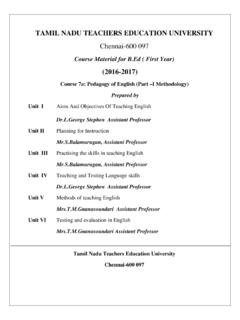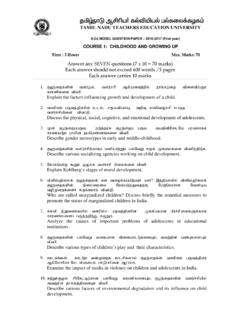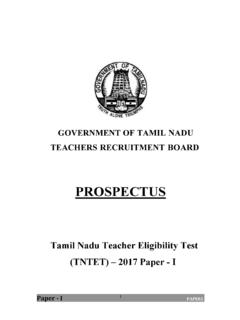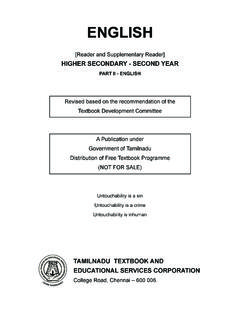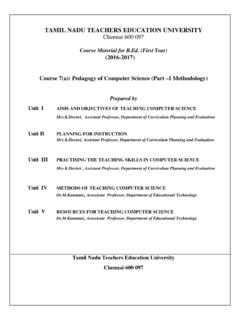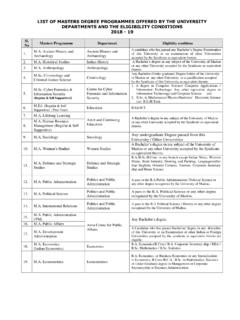Transcription of TAMIL NADU TEACHERS EDUCATION UNIVERSITY …
1 TAMIL nadu TEACHERS EDUCATION UNIVERSITY Chennai 600 097 Course Material for (First Year) (2016-2017) Course 1: Childhood and Growing Up Prepared By Unit VI : Marginalized children: issues and concerns Shanmugam, Assistant Professor Unit VII &VIII: Understanding adolescence & Play and child development , Assistant Professor Rajammal, Assistant Professor Unit IX & X : Media and child development & Urbanization and economic change on child development.
2 , Professor and Head , Assistant Professor Department of Educational Psychology TAMIL nadu TEACHERS EDUCATION UNIVERSITY Chennai 600 097 Course 1 : Childhood and Growing up Department of Educational Psychology, TNTEU,Chennai-97. 2 UNIT VI: MARGINALIZED CHILDREN: ISSUES AND CONCERNS Objectives: After completion of the unit, the learner will be able to: 1. learn the meaning of marginalized children 2. understand the issues of slum children, street children, abused child 3. analyse the measures to promote the status of marginalized children Introduction Marginality is an experience that affects millions of people throughout the world. People who are marginalized have relatively little control over their lives, and the resources available to them.
3 This results in making them handicapped in delving contribution to society. A vicious circle is set up whereby their lack of positive and supportive relationships means that they are prevented from participating in local life, which in turn leads to further isolation. This has a tremendous impact on development of human beings, as well as on society at large. As the objective of development is to create an enabling environment for people to enjoy a productive, healthy, and creative life, it is important to address the issue of marginalization. Development is always broadly conceived in terms of mass participation. Marginalization deprives a large majority of people across the globe from participating in the development.
4 It is a complex problem, and there are many factors that cause marginalization. This complex and serious problem need to be addressed at the policy level. This project deals with the problems associated with the groups suffering from marginalization and the ways to reduce them. Meaning Amarginalized children is a group of children that's confined to the lower or peripheral edge of the society. Such a group is denied involvement in mainstream economic, political, cultural and social activities. Concept The process whereby something or someone is pushed to the edge of a group and accorded lesser importance. This is predominantly a social phenomenon by which a minority or sub-group is excluded, and their needs or desires ignored.
5 In general, the term marginalization describes the overt actions or tendencies of human societies, where people who they perceive to undesirable or without useful function, are excluded, , marginalized. These people, who are marginalized, from a group or community for their protection and integration and are known as marginalized groups . This limits their opportunities and means for survival. Peter Leonard defines marginality as, being outside the mainstream of productive activity and/or social reproductive activity . Course 1 : Childhood and Growing up Department of Educational Psychology, TNTEU,Chennai-97. 3 Characteristics of marginalized groups: Usually a minority group has the following characteristics 1) It suffers from discrimination and subordination.
6 2) They have physical and/or cultural traits that set them apart, and which are disapproved of, by a dominant group. 3) They share a sense of collective identity and common burdens. 4) They have shared social rules about who belongs, and who does not. 5) They have a tendency to marry within the group. CHILDREN LIVING IN URBAN SLUM: Issues of children living in urban slum: 1. Children were defined more by their behavior than by their age 2. Aside from poverty or health problems, the top rated harms to children were: being out of school sexual exploitation and abuse drug and alcohol abuse early pregnancy. Drug and alcohol abuse were rated as a much more serious forms of harm to children in one slum than in the other. Also, socio-economic status influenced the relative rankings.
7 3. Primary causes of children being out of school were: inability to pay school fees family demands that children work parental neglect pregnancy discrimination against non-biological children within the household negative peer influences beatings by TEACHERS . 4. Sexual abuse and exploitation of children was reportedly rampant in both slums, and the perpetrators frequently included people in positions of power and authority, such as TEACHERS and elders. Teenage girls were more likely than any other sub-group to rate this as the top harm to children. Women frequently used their daughters to attract male customers, who became drunk and abused the girls. Sexual abuse also occurred frequently at funerals, disco dances, and video halls.
8 Men frequently gave fried potatoes to girls as young as six years of age as a means of enticing them to have sex. Pre-teenage and teenage girls were sexually active; many traded sex for desired objects or benefits. Course 1 : Childhood and Growing up Department of Educational Psychology, TNTEU,Chennai-97. 4 5. Early pregnancy was widespread; significant numbers of girls reportedly became pregnant in their early teens. Contributing factors were children regularly watching their parents have sex and then imitating them, parental neglect, and alcohol and drug use. Whatever the causes, early pregnancy served as a gateway to sexual exploitation. 6. Alcohol and drug use were pervasive.
9 Adults attributed the use of alcohol and drugs to children s disobedience, bad behavior, and bad peer group influences, while teenagers attributed the problems mostly to the stresses of living in the slums. 7. Children aged 5 12 years frequently had different views from teenagers and adults of the main kinds of harm they face. Younger children did not like getting hit, seeing parents fight, or seeing people who had been burned, stabbed, or killed. 8. For the most part, the pathways of response to these and other problems were through the extended family and community groups, such as religious groups, women s groups, and youth groups. 9. Chiefs, elders, police and others were connectors who linked communities with the formal system. The formal child protection system was used in situations such as the rape of a child by someone from outside the child s family.
10 Such an offence was sometimes reported to the police, who arrested the perpetrator, took the child for medical treatment, and conducted an investigation. Nearly two-thirds of the participants said people were unwilling to report such offences to the authorities. 10. Aside from the family, religion emerged as one of the most important preventive factors. For both Christians and Muslims, religion was seen as fundamental in moral EDUCATION and teaching children good values. Also, Muslim and Christian organizations helped to keep children in school by raising funds to pay school fees. Youth groups were particularly important preventive factors in regard to the use of drugs. Concerns for Children Living in Urban Slum 1 The 74th Constitutional Amendment of 1992, which proposes that urban local bodies (ULBs) should have a direct stake in urban poverty alleviation and slum improvement and upgrading, with participation of citizens 2 The Jawaharlal Nehru National Urban Renewal Mission (JNNURM), launched in December 2005, which embodies the principles of the 74th Constitutional Amendment.



